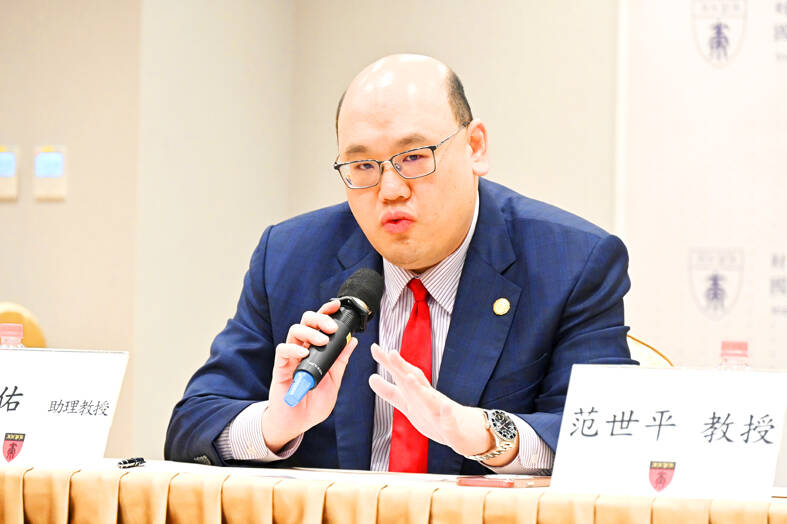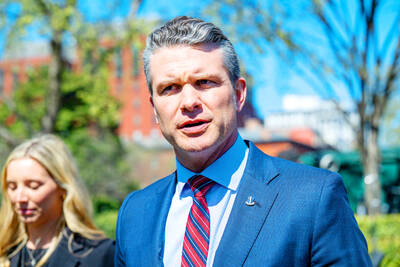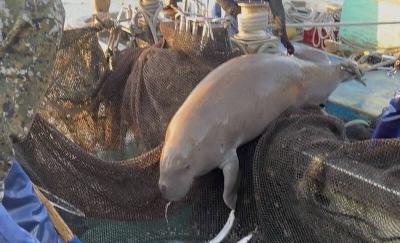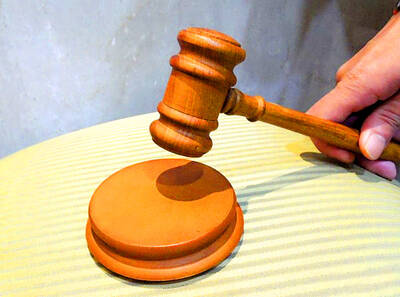China’s military drills around Taiwan this week were aimed at testing the US’ response and strategic bottom line ahead of a potential Washington-Beijing summit, rather than the stated goal of deterring “Taiwanese independence” forces, academics said.
The Chinese People’s Liberation Army’s (PLA) Eastern Theater Command on Tuesday announced it had launched a new round of exercises around Taiwan using army, navy, air and rocket forces to “close in” on the nation from “multiple directions.”
Last night the PLA announced it had concluded the two days of drills.

Photo: Tu Chien-jung, Taipei Times
China’s Taiwan Affairs Office (TAO) said the drills were intended as “a stern warning” to “Taiwanese independence” separatist forces, and would serve as “a resolute punishment” for what it called the “reckless provocations to seek independence” by the administration of President William Lai (賴清德).
Lin Ying-yu (林穎佑), an assistant professor at Tamkang University’s Graduate Institute of International Affairs and Strategic Studies, said the exercises, coming just after US Secretary of Defense Pete Hegseth visited Japan, were aimed at the US.
During his first trip to Japan after taking office, Hegseth met with Japanese Minister of National Defense Gen Nakatani in Tokyo, where they discussed security issues across the Strait.
“The ministers took note of activities by the PLA including the military situation around Taiwan, and emphasized the importance of peace and stability across the Taiwan Strait,” an English-language news release issued by the Japanese Ministry of Defense said.
Despite its rhetoric of “opposing Taiwanese independence” as the reason for launching the drills, China’s decision to start them right after Hegseth’s departure was about testing the US’ bottom line and response regarding security issues across the Strait, Lin said.
Beijing also wanted to understand US President Donald Trump’s stance on the issue, with the aim of gauging the US strategic position ahead of a potential summit between Trump and Chinese President Xi Jinping (習近平), he said.
Echoing Lin, Su Tzu-yun (蘇紫雲), director of the Division of Defense Strategy and Resources at the Taiwan military-funded Institute for National Defense and Security Research, said the drills were aimed at expressing political dissatisfaction toward Washington.
That dissatisfaction stemmed from a Washington Post report published on Saturday last week that said an internal guidance memo signed by Hegseth had reoriented the US military to focus on deterring a potential seizure of Taiwan by China, Su said.
While the PLA’s surprise drills were primarily intended as a message to the US, they might also serve as internal propaganda in China, he said.
The exercises could also be seen as a response to Lai’s speech on March 13, in which he designated China a “foreign adversary” and announced 17 strategies to counter Beijing’s coercion of Taiwan, he said.
Chieh Chung (揭仲), a research fellow at the Association of Strategic Foresight, said the Lai administration was directly named in statements and in videos on the drills by the TAO and the PLA, adding that such direct references showed that the drills could be seen as a response to Lai.
The criticism and the drills could be interpreted as signs that Beijing might be using Lai’s remarks as a pretext to raise tensions across the Strait ahead of a potential Xi-Trump summit, in a bid to gain leverage or create opportunities for negotiation with the Trump administration, Chieh said.

‘DENIAL DEFENSE’: The US would increase its military presence with uncrewed ships, and submarines, while boosting defense in the Indo-Pacific, a Pete Hegseth memo said The US is reorienting its military strategy to focus primarily on deterring a potential Chinese invasion of Taiwan, a memo signed by US Secretary of Defense Pete Hegseth showed. The memo also called on Taiwan to increase its defense spending. The document, known as the “Interim National Defense Strategic Guidance,” was distributed this month and detailed the national defense plans of US President Donald Trump’s administration, an article in the Washington Post said on Saturday. It outlines how the US can prepare for a potential war with China and defend itself from threats in the “near abroad,” including Greenland and the Panama

A wild live dugong was found in Taiwan for the first time in 88 years, after it was accidentally caught by a fisher’s net on Tuesday in Yilan County’s Fenniaolin (粉鳥林). This is the first sighting of the species in Taiwan since 1937, having already been considered “extinct” in the country and considered as “vulnerable” by the International Union for Conservation of Nature. A fisher surnamed Chen (陳) went to Fenniaolin to collect the fish in his netting, but instead caught a 3m long, 500kg dugong. The fisher released the animal back into the wild, not realizing it was an endangered species at

The Chinese Nationalist Party (KMT) is maintaining close ties with Beijing, the Democratic Progressive Party (DPP) said yesterday, hours after a new round of Chinese military drills in the Taiwan Strait began. Political parties in a democracy have a responsibility to be loyal to the nation and defend its sovereignty, DPP spokesman Justin Wu (吳崢) told a news conference in Taipei. His comments came hours after Beijing announced via Chinese state media that the Chinese People’s Liberation Army’s Eastern Theater Command was holding large-scale drills simulating a multi-pronged attack on Taiwan. Contrary to the KMT’s claims that it is staunchly anti-communist, KMT Deputy

The High Prosecutors’ Office yesterday withdrew an appeal against the acquittal of a former bank manager 22 years after his death, marking Taiwan’s first instance of prosecutors rendering posthumous justice to a wrongfully convicted defendant. Chu Ching-en (諸慶恩) — formerly a manager at the Taipei branch of BNP Paribas — was in 1999 accused by Weng Mao-chung (翁茂鍾), then-president of Chia Her Industrial Co, of forging a request for a fixed deposit of US$10 million by I-Hwa Industrial Co, a subsidiary of Chia Her, which was used as collateral. Chu was ruled not guilty in the first trial, but was found guilty